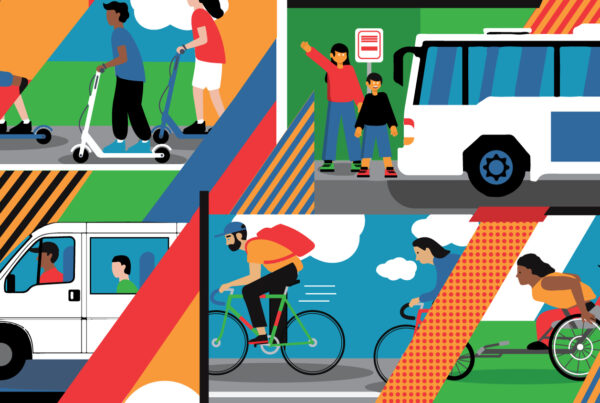What happens when bigger isn’t better?
It’s one thing to provide a novel service, but quite another to achieve success at scale without losing touch with the people and product that enabled your growth. Representatives from some of the shared mobility industry’s biggest companies – including Zipcar, car2go, Lyft, Getaround, Bcycle and Motivate – gathered at the national shared mobility summit Move Together in Chicago earlier this fall to share insights on the strategies they used to expand without losing their mojo – or their customers.
From overcoming user experience snafus to jumping on new opportunities, panelists reflected on growing pains, discussed inflection points and shared lessons that other shared mobility companies can use in their efforts to scale up:
1. Don’t Be Afraid to Experiment
Lyft’s Director of Transportation Policy Emily Castor talked about the ridesourcing company’s early struggles to provide a reliable supply of drivers to meet demand in new markets. After all, who wants to hail a Lyft ride when the nearest vehicle is 10 minutes away? According to Castor, Lyft tried to keep new markets flooded with drivers by guaranteeing them a minimum hourly rate. However, that approach ultimately failed to bring new cities to a self-sustaining level. Lyft then decided to experiment with offering potential customers two weeks of unlimited ride credits and compensating drivers each time a new person joined the system, an approach that was ultimately much more effective.
“The drivers were incentivized to be much more entrepreneurial about positioning themselves in places where they were likely to get riders, and passengers were encouraged to build a habit,” said Castor.
2. Focus on the User Experience
Peer-to-peer carsharing provider Getaround originally relied on car owners and renters to meet in person to exchange keys. Not only was the process inefficient but – according to Padden Murphy, Getaround’s head of public policy and business development – it resulted in a horrible user experience. So, Getaround went back to the drawing board and re-launched operations in several cities using its new Getaround Connect™ technology, which allows members to access a car they’ve reserved online using their mobile device instead of having to swap keys.
“If you can’t get the thing that you need from a couple of click on the phone, then you’re not going to return to the service,” said Murphy. He suggested companies focus on decreasing friction and ensuring that their product can keep up with the speed of consumption in today’s marketplace.
3. Go Dense or Go Home
When launching a new system, it can be tempting to cover a wide geographic area to reach as many new users as possible. But without sufficient density, meeting demand can be problematic. Car2go Business Development Manager Walter Rosenkranz discussed the importance of density as it relates to one-way carsharing. “With-point-to-point, you can’t just tiptoe into a market,” he said. At the same time, he continued, sometimes you underestimate the demand in a market, which can result in disappointed customers.
Maintaining density can mean saying no to some opportunities. For instance, Getaround’s Padden Murphy said that his company has learned it’s best to turn down people who want to rent out their cars but don’t live within Getaround’s established service areas. Recently, car2go has also been readjusting its service areas in cities such as Denver and Calgary to ensure that vehicle utilization rates remain high in core neighborhoods.
Density is also a major issue for bikesharing, as systems designed with stations more than 1,000 feet apart (roughly a 5 minute walk) have generally experienced lower ridership. According to Bcycle President Bob Burns, his company has learned that bikeshare systems don’t have to be big to succeed – just dense. “You need to keep the stations close together so people can actually get from one place to another,” said Burns.
4. Don’t Go it Alone
Building on the theme of partnerships, which resonated throughout several conference sessions, panelists also reminded up-and-coming entrepreneurs that they’re not in it alone. At some point everyone needs outside help, whether it’s from a local government, mentor or outside consultant.
Justin Ginsburgh, vice president of business development for bikesharing provider Motivate, discussed how his company decided to bring in additional expertise – both in the C-suite and from outside consultants – when the company purchased Alta Bikeshare and secured a big new investor.
“Being recapitalized and having experienced business leaders at the helm helped Motivate scale and move forward,” he said. Additionally, according to Ginsburgh, partnerships are the base ingredient in the “secret sauce” – which involves aligning incentives between riders, the operator and local government – that makes bikeshare work.
Bcycle’s Bob Burns agreed. “Bikeshare needs to be supported by communities with funding and political cover,” he said. “The business model is reliant on strong local political support and a solid local operator.”
Justin Holmes, Zipcar’s Director of Corporate Communications and Public Policy, also discussed the important role that public-private partnerships have played in his company’s success, ranging from Zipcar’s public sector fleet management solutions to its need to work with local government to secure on-street parking for carsharing vehicles. “Cities are playing an increasingly important role in setting the stage,” Holmes said.
As the shared mobility industry continues to grow and mature, change is inevitable. But by continuing to innovate while keeping the focus on their customers, companies can expand with their DNA intact.
To keep up to date on the latest developments in the shared mobility industry – and for information on the 2016 national shared mobility summit – be sure to subscribe to SUMC’s newsletter.


